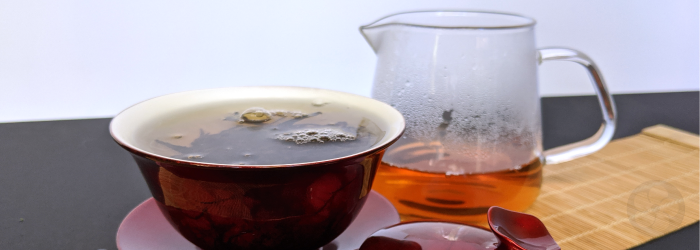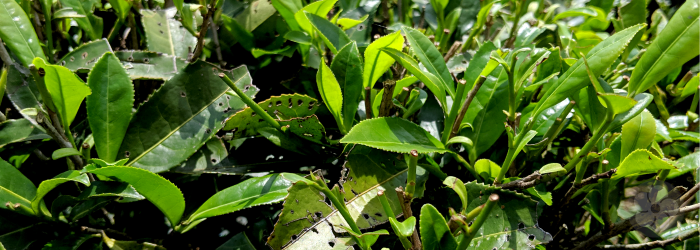What is Oriental Beauty Tea?

Also known as Dongfang Meiren (“Eastern Beauty”), Bai Hao Oolong (“White Tip Oolong”) and Pengfeng Cha (“Braggart’s Tea”), Oriental Beauty is a unique and famous tea. Traditionally, it is grown in Hsinchu County, in the north of Taiwan. Here, the mountains give way to rolling hills, and the mild climate is ideal for growing tea. It’s probable that immigrants from the Chinese mainland started planting tea bushes here in the Ming Dynasty, and possible that these first bushes included the variety that would become Oriental Beauty.
Learn more about how traditional varieties shape tea flavor >>
It was not until 1933 that Oriental Beauty was introduced to the commercial market, after winning accolades in a tea competition. At the time, the Taiwanese government was making an effort to increase the quality of tea for export, and tea competitions were a fantastic way for them to reward farmers for making high quality tea. Buyers of the first batch of Oriental Beauty included the governor's office, and the tea fetched such high prices that the proud farmer’s boasts inspired the name “Braggart’s Tea”.
Flavor to Brag About
The secret of this captivating tea was not its variety or provenance, though they certainly contributed. Instead, it was the bites of the green leafhopper that transformed this summer harvest into a prizewinning brew. Though it was certainly unexpected at the time, modern science has shed some light on the chemical effects of these attacks. The natural sweetness that develops is a direct byproduct of the plant’s natural defenses, as it produces a unique enzyme to attract predators of the attacking leafhopper. Today, other tea farmers capitalize on this effect as well, making bug bitten teas in a variety of styles.
Find out why bug bitten teas are naturally sweet >>
Bug bitten teas are usually given the name mi xiang, or “honey fragrance”. A well made mi xiang tea has a distinct honeyed aroma, as well as a characteristic sweetness on the palate, from the defensive enzymes released by the plant. For the tea tasters at that 1933 competition, the flavor must have been utterly unique and unexpected, since these visibly damaged leaves would have been discarded by most other farmers. In addition, Oriental Beauty is heavily oxidized, which brings forth an undeniable fruity note in this and other mi xiang teas.
Learn more about bug bitten teas with Alice in this video:
Today, there are many grades of Oriental Beauty, as with any tea. The best versions use a young leaf harvest from the summer months. This crop includes leaves that are sturdy enough to withstand rolling and oxidation, but are also young enough to be relatively high in carbohydrates and low in bitterness. The result is a smooth brew with a rich mouth feel.
Learn why harvest date determines tea quality >>
Reputation vs. Reality
It may not be a surprise to learn that this tea, originally made famous by the high prices it fetched, is often pricy. Really, this is totally justified: bug bitten crops can have yields reduced by more than half, due to the damage caused to the leaves. A leaf that is bitten too much is simply bitter, and the mi xiang flavor can be completely offset by a rain before the harvest. This is a tea with a naturally small supply, and a big reputation both domestically and internationally.
Unfortunately, this leads to the same proliferation of imitations we see with other famous varieties. Low grades of Oriental Beauty may be crafted with broken leaves, or larger, more mature leaves where the tiny bug bites have a smaller impact. Since the Taiwanese leafhopper was recently discovered to be the same species as those in China, Oriental Beauty is now produced on the mainland as well, where differences in provenance and variety can make a real flavor difference. Some imitations of Oriental Beauty tea may not even be bitten by bugs at all, resulting in a more floral flavor and a vegetal bite.
Find out what criteria we use to define a ‘good’ tea >>
Finally, even high quality versions of traditional Oriental Beauty often lack the finish and depth of other Taiwanese teas, like those grown at high elevations. This is simply a function of the provenance and harvest season, as the traditional summer leaves grow quickly, and don’t have much time to develop complex flavor compounds. All in all, it’s quite rare that we come across a tea with this name that is worth the asking price.
Our most recent sourcing trip, however, brought us an unexpected exception: a modern take on this traditional style, grown at high elevation on Alishan, under the modern name Eastern Beauty. Rather than leafhoppers, this crop is bitten by aphids, but the enzymatic reaction in the plant is much the same, producing the characteristic sweetness that Oriental Beauty is known for, along with intense fruity nuance. Grown from a traditional oolong variety near the peak of the mountain, the bright, honeyed top notes are underscored by a lingering finish with surprising richness, and no astringency. We were so impressed by this tea we’ve made it part of our exclusive Red Label Collection.
Order now to taste our unique Eastern Beauty >>
Have you tried Oriental Beauty tea? Let us know what you think about this variety in the comments!
Sign up for our newsletter to get blog updates in your inbox!






Comments on this post (3)
This aphid-bitten Alishan is really intriguing! Aphids are usually pretty patchy in tea fields, as they don’t move around like leafhoppers do, but rather tend to live and feed gregariously near their mothers. This must be an especially challenging tea to produce.
— Eric
Hi Letitia,
Thanks for your comment. As described in the blog post, Oriental Beauty or 東方 美人茶 is a style of tea defined by Taiwanese origin, bug-bitten leaves, and a high level of oxidation. We carry this tea under the English name Eastern Beauty. Our selection is grown on Alishan, is aphid-bitten, and is fully oxidized to create a black tea. We love this tea so much we’ve made it part of our Red Label Collection!
— Amy Covey
This is the brand I’m looking for: Oriental Beauty Oolong Tea / Dongfang Meiren (東方美人茶)
Do you know where I can purchase this? Thanks!
— Letitia Leung